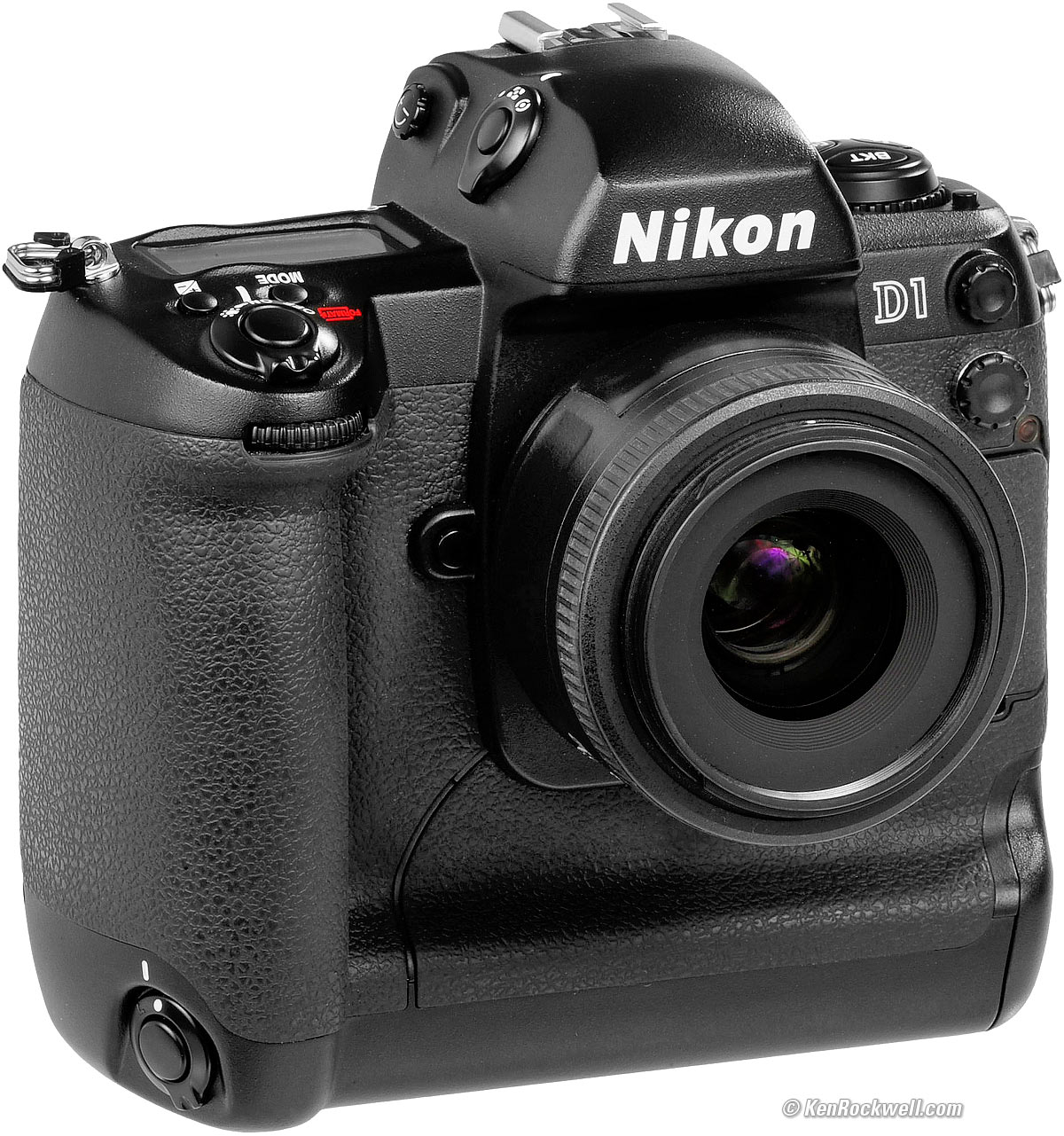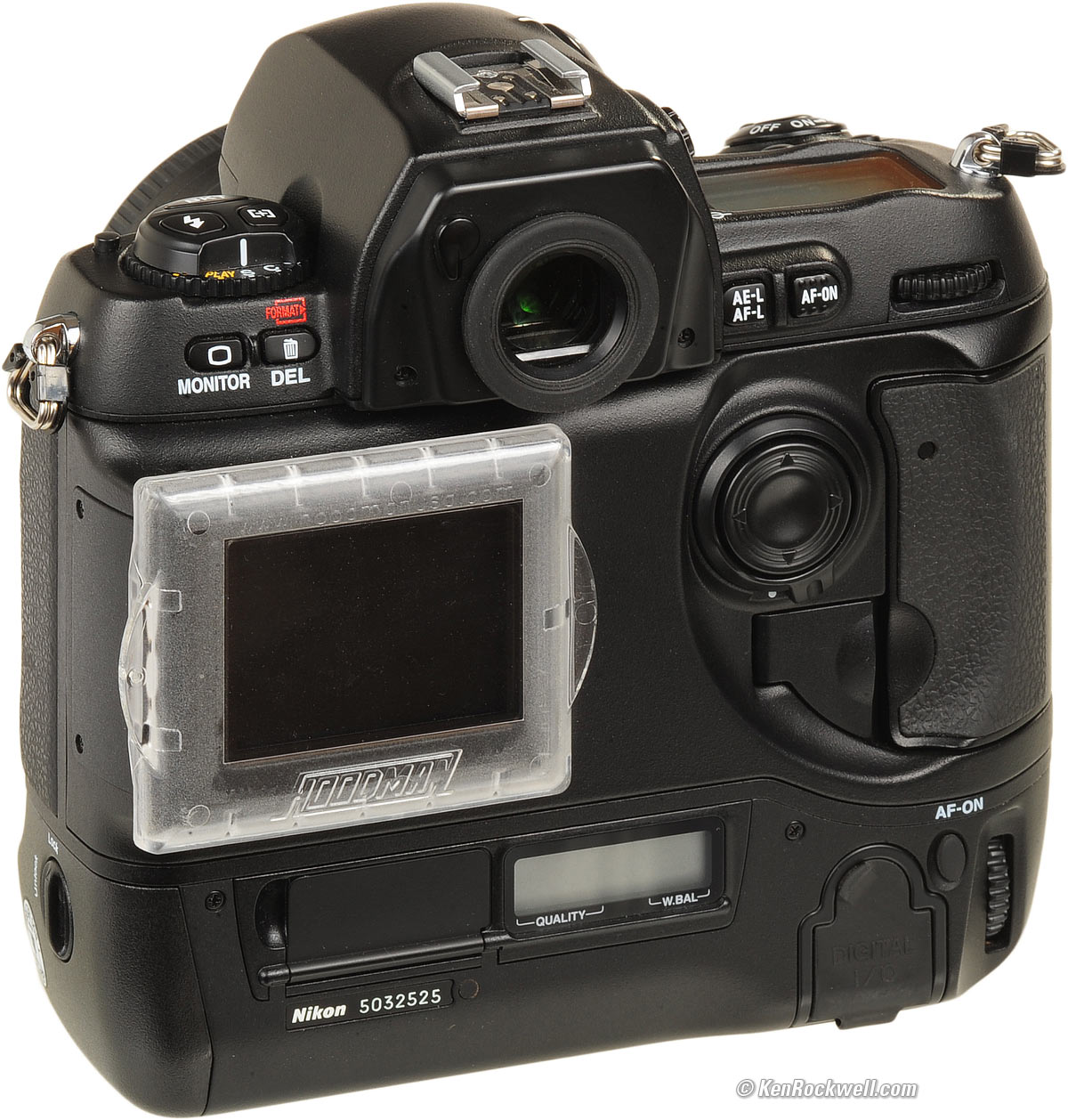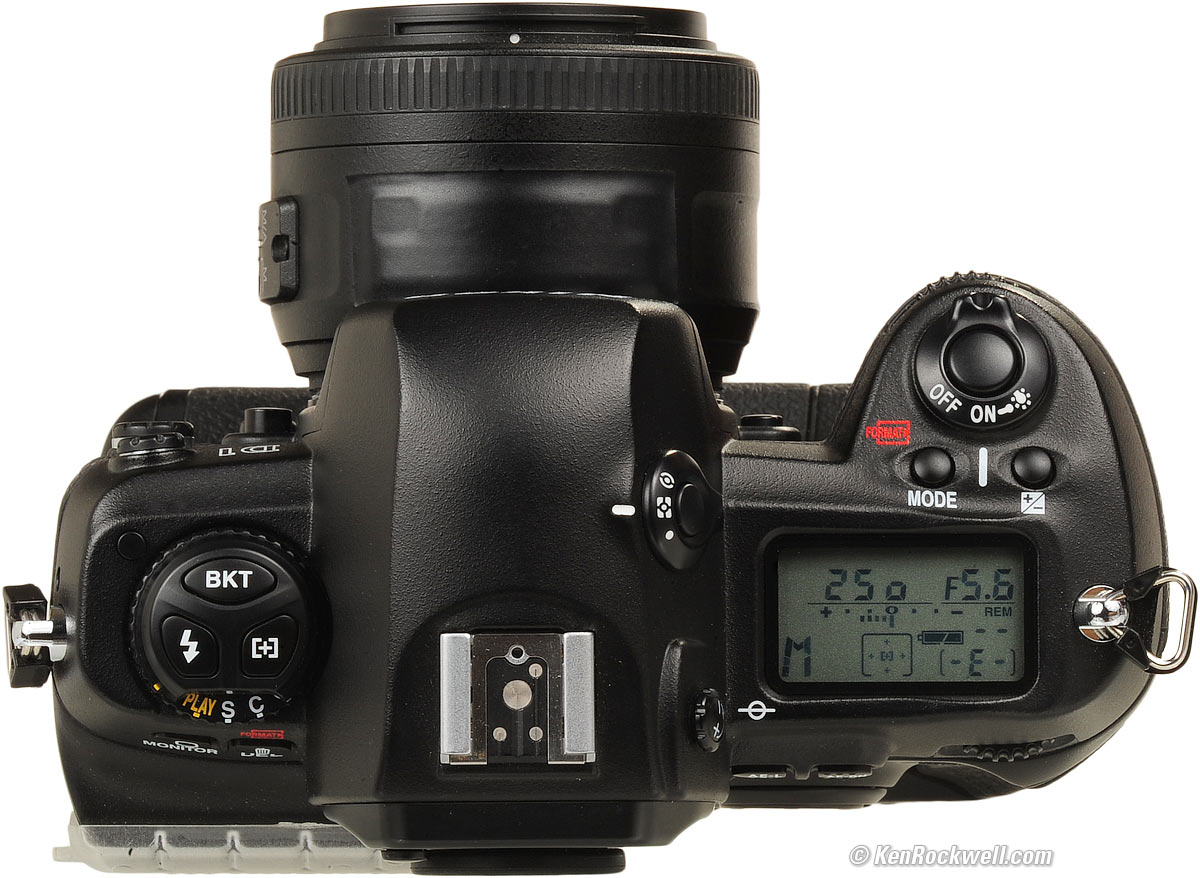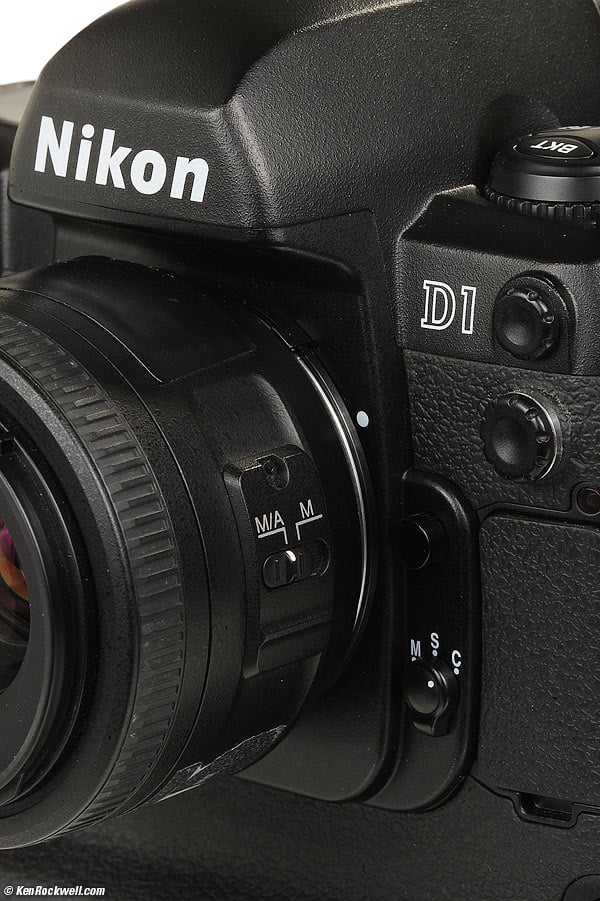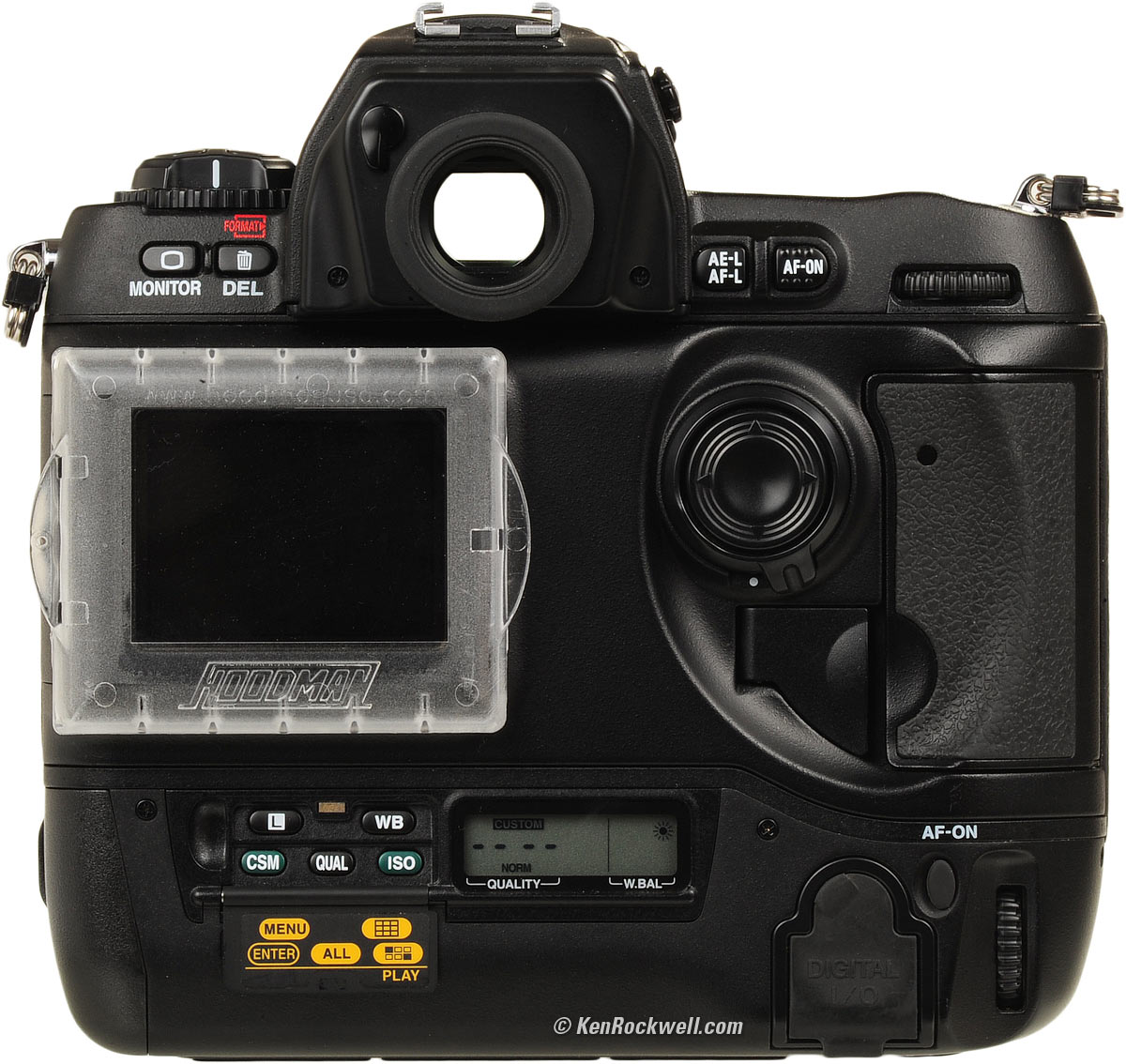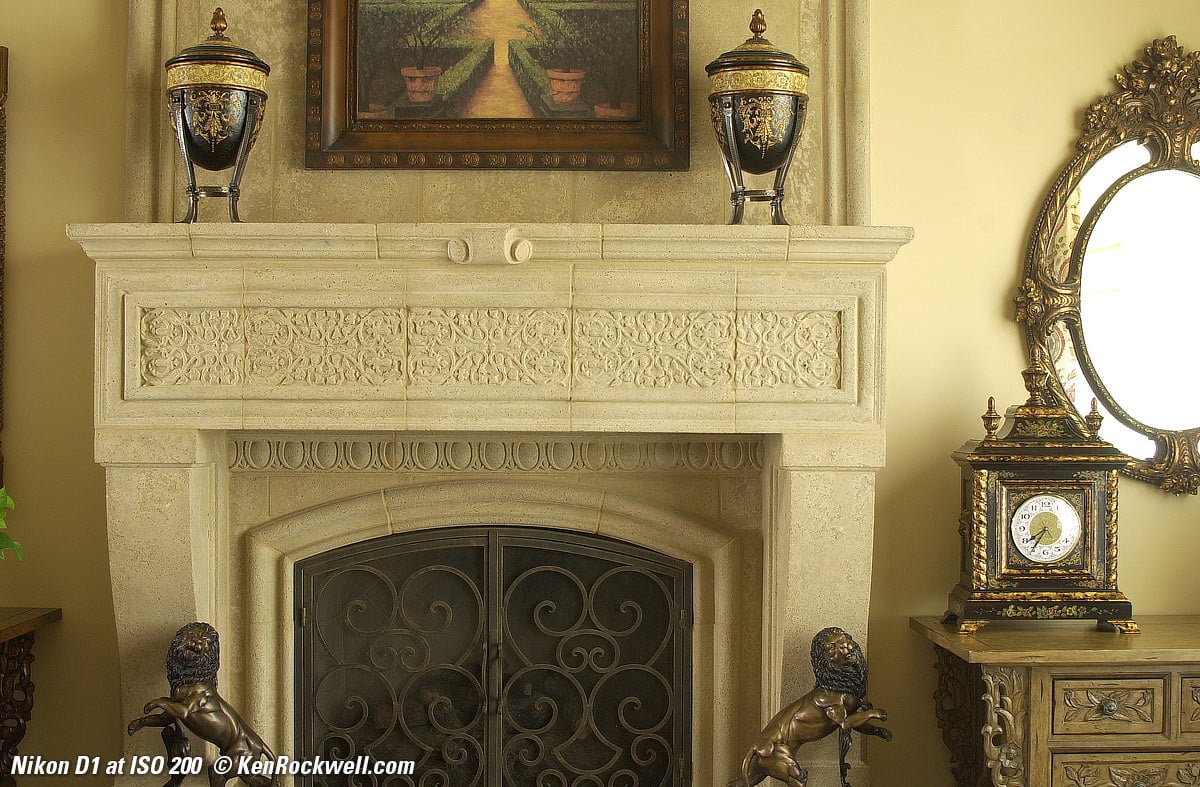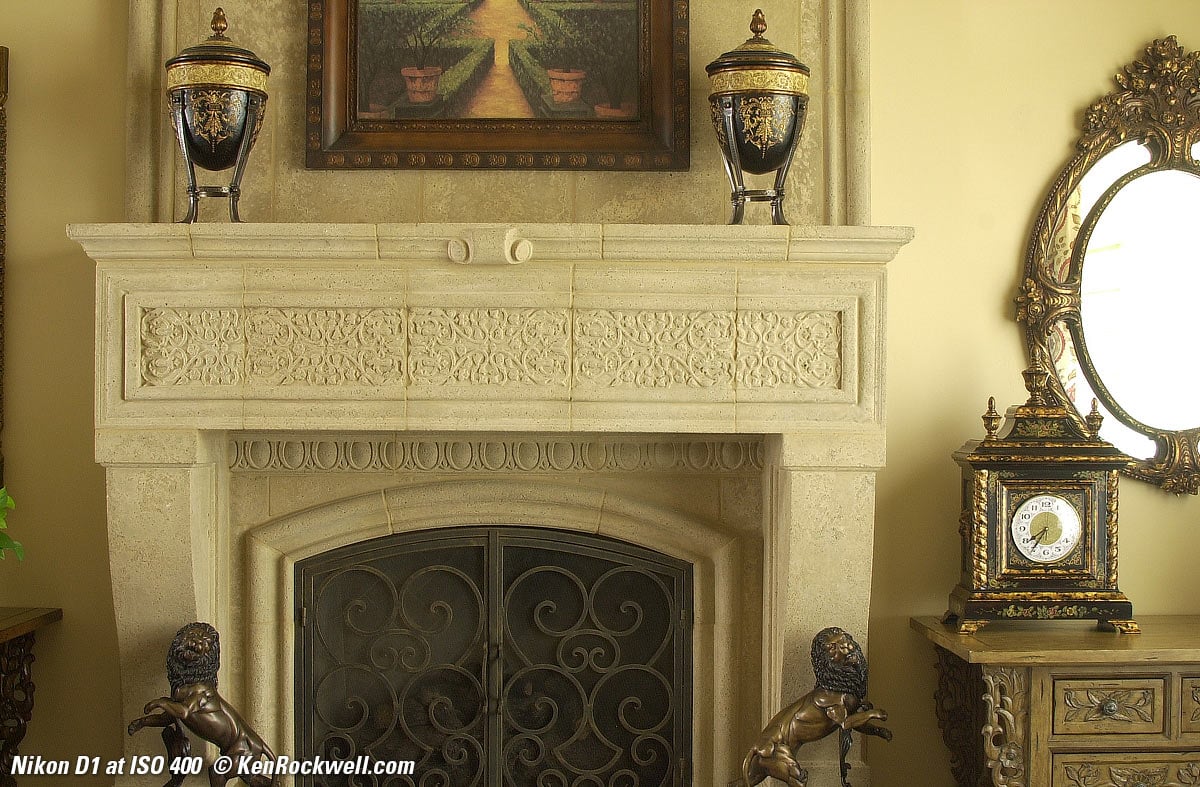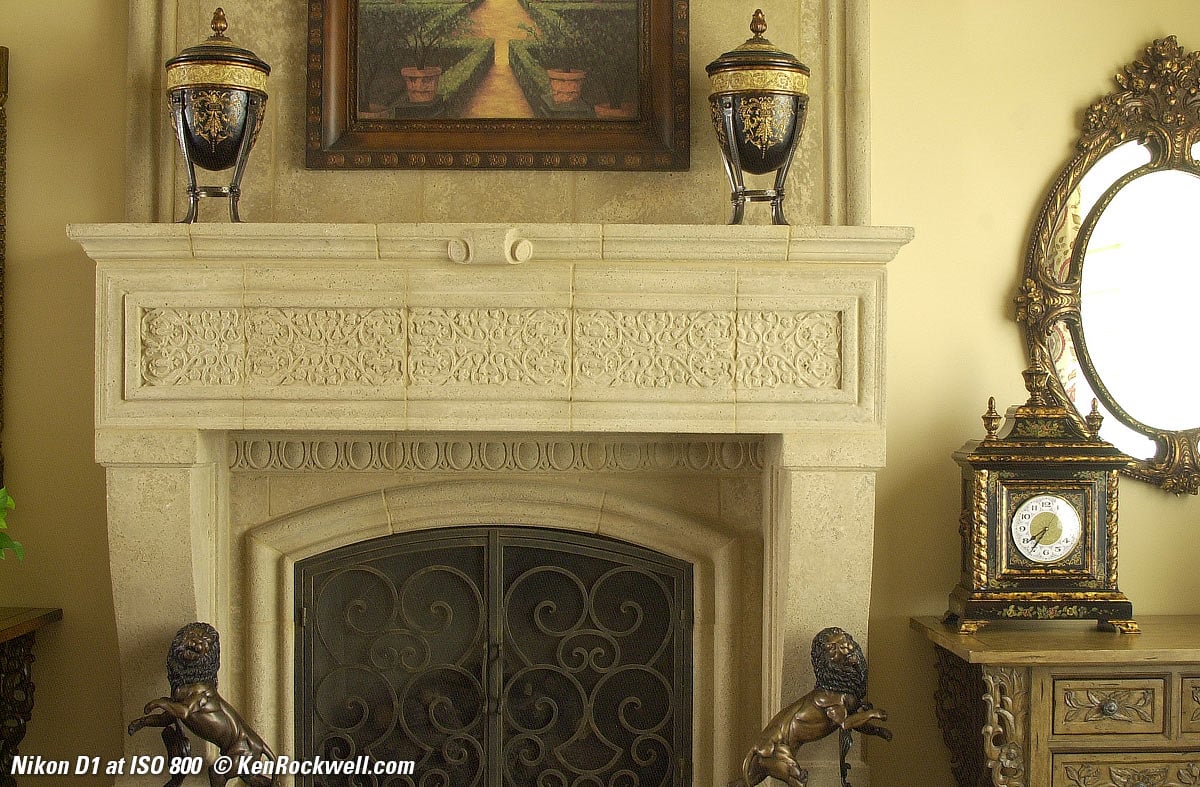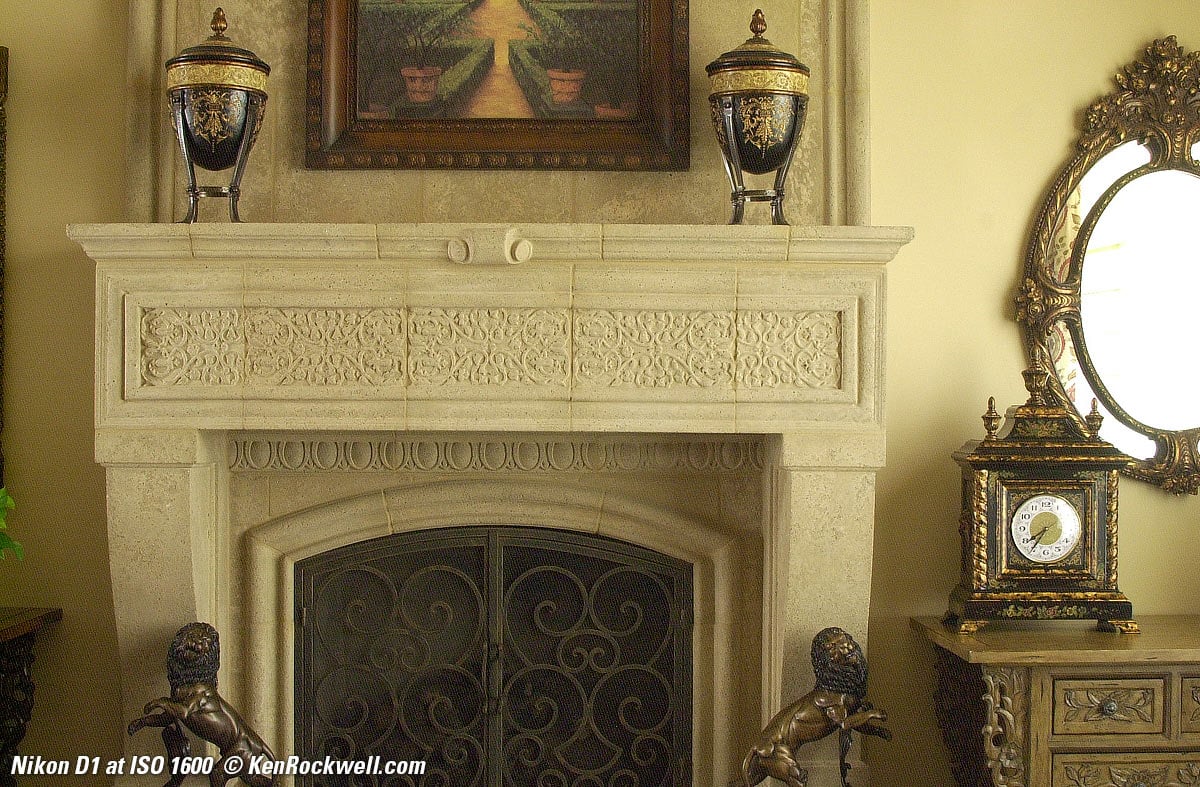Home Donate New Search Gallery Reviews How-To Books Links Workshops About Contact
Nikon D1
World's First Practical DSLR
2.6 MP DX, 4.5 FPS, 2" LCD, 1/16,000 shutter, 1/500 sync (1999‑2001)
Intro Specs Performance Compared Usage Recommendations More
Nikon D1 (46.860 oz./13.285g with Watson EN4 battery and CF card, was $4,999 new and now about $100 used) and 35mm f/1.8 DX. enlarge. This free website's biggest source of support is when you use these links, especially this link directly to them at eBay (see How to Win at eBay), when you get anything, regardless of the country in which you live. Thanks! Ken.
May 2018 More Nikon Reviews Nikon Lenses All Reviews
High ISO Comparison May 2012
Pro DSLR Comparison 03 February 2016
Back, Nikon D1. enlarge.
Nikon D1 and 35mm f/1.8 DX. enlarge.
Nikon D1 and 35mm f/1.8 DX. bigger.
Nikon D1 and 35mm f/1.8 DX. enlarge.
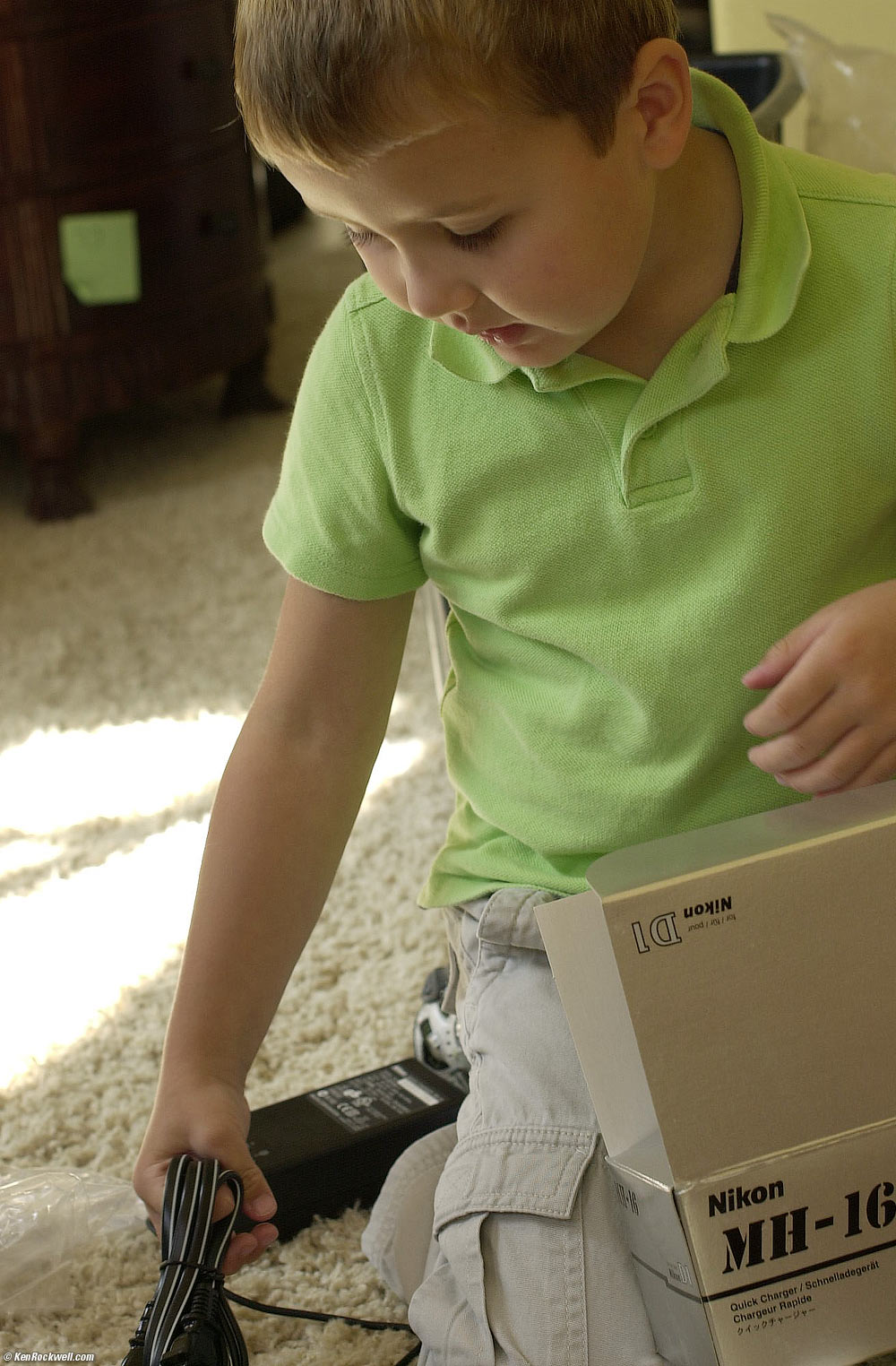
Ryan opens the new charger for Dada's new Nikon D1 "digital" SLR, 27 September 2011. (1999 Nikon D1, AF-Continuous, top AF area, Nikon 50mm f/1.4 G, ISO 200, Auto -3 White Balance, low contrast, high sharpening, Matrix meter, Program at 1/100 at f/5.)
Introduction top
Intro Specs Performance Compared Usage Recommendations More
|
I buy only from these approved sources. I can't vouch for ads below. |
The Nikon D1 is the world's first practical DSLR. There were DSLRs long before the D1, but they had five-figure price tags and worked poorly.
The breakthrough of the D1 is that it's low price ($4,999) and high speed (4.5 FPS, 1/16,000 shutter and unlimited flash sync), use of common Compact Flash cards for storage and high resolution (2,000 x 1,312) made it a no-brainer for news photography.
It's weak points were that it had horrible highlight rendition; anything more than about a stop overexposed was completely blown-out, and that its batteries always read dead and only gave a couple of hundred shots per charge. We had to carry two or three spares with us on any job, and the batteries were big and heavy. Worse, as batteries aged, a design flaw led to a problem where the camera seems to shoot, but records a black frame instead of the image we wanted! As of 2018 I use a new Watson EN4 battery which works fine.
Specifications top
Intro Specs Performance Compared Usage Recommendations More
Lens Compatibility
Works with all AF, AF-D, AF-I, AF-S, FX, DX and G lenses, as well as all AI and AI-s manual focus lenses. In other words, works with everything.
Meters fine with manual lenses, but center-weighted metering only.
ISO
200, 400, 800 and 1,600.
Power
EN-4 Ni-MH battery.
I bought this Lenmar Ni-MH EN-4 replacement battery for $24 in 2011 and it worked great until 2018. I now use a Watson EN4 batteries at B&H in 2018 and it works fine, even if the charger connection is very tight.
Good news is that the end cap of the Watson EN4 mates perfectly with the camera, something that 3rd party batteries never did back in the day - and Goodness knows I tried enough of them back in the 2000s because they were all so awful, especially Nikon's!
Nikon's D1 Specifications
Type of Camera
Lens-interchangeable SLR-type digital camera
CCD
23.7 x 15.6mm RGB CCD; 2.74 million total pixels
2.66-million effective pixels (2,012 x 1,324 array)
captures 12-bit full-color image
Image Size
2,000 x 1,312 pixels
Sensitivity
ISO equivalency 200, 400, 800, 1,600
Storage
System: Digitally stored;
JPEG Baseline (approx. 1/4, 1/8, 1/16 compressed),
uncompressed (12-bit Raw*, 8-bit YCbCr-TIFF*,
8-bit RGB-TIFF), monochrome mode
* Optional software is needed to reproduce images;
“Nikon Capture” for Raw/YCbCr-TIFF images,
“Nikon View DX” for YCbCr-TIFF images
Media: CompactFlashTM (CF) Card (Type I/II)
Modes and No. of frames (With EC-64CF 64MB CF Card):
Raw (uncompressed Raw) — approx. 16
Hi (uncompressed YCbCr-TIFF) — approx. 12
Hi (uncompressed RGB-TIFF) — approx. 7
Fine (approx. 1/4 compressed) — approx. 48
Normal (approx. 1/8 compressed) — approx. 97
Basic (approx. 1/16 compressed) — approx. 195
Shooting Modes
1) Single frame shooting (S) mode: advances one frame for each shutter release; capture preview mode available
2) Continuous shooting (C) mode: approx. 4.5 frames per sec. (up to 21 consecutive shots)
3) Self-timer (Sf) mode: time duration can be set
4) Playback (Pb) mode: playback, menu setting
5) PC (Pc) mode: data transfer via personal computer
White Balance
1) Auto (TTL control with 1,005-pixel CCD)
2) Manual (6 settings with 7-step fine tuning)
3) Preset
LCD Monitor
2-in., 120,000-dot, low temp. polysilicon TFT LCD; backlight/brightness adjustment available
Playback Menu
1) Protect setting
2) Hide setting
3) NTSC/PAL switching,
4) Indication directory switching
Playback Function
1) 1 frame
2) Thumbnail (9 segments)
3) Slide show
4) Histogram indication, highlight point display and focus confirmation indication
Delete Function
1) Card format
2) All frames delete
3) Selected frames delete
Video Output
NTSC or PAL (switchable)
Interface
IEEE1394 (FireWire)
Exposure Mode
1) [P] Programmed Auto (Flexible Programme possible)
2) [S] Shutter-Priority Auto
3) [A] Aperture-Priority Auto
4) [M] Manual; shutter speed/aperture adjustable in 1/2 or 1/3 EV steps
Usable Lenses
1) D-type AF Nikkor: All functions possible
2) D-type Manual-Focus Nikkor: All functions except autofocus possible
3) AF Nikkor other than D-type: All functions except 3D Color Matrix Metering and 3D Multi-Sensor Balanced Fill-Flash for D1 possible,
4) AI-P Nikkor: All functions except 3D Color Matrix Metering, 3D Multi-Sensor Balanced Fill-Flash for D1 and autofocus possible
5) Non-CPU: Usable in [] or [] mode, Centre-Weighted or Spot Metering;
Electronic Rangefinder usable with lens with maximum aperture of f/5.6 or faster
Note: When Non-CPU lenses are used, [A] mode is selected automatically for [P] or [S] mode, also Centre-Weighted Metering is selected for 3D Color Matrix Metering.
Picture Angle
Approx. 1.5x focal length in 35mm [135] format equivalent
Viewfinder
Optical-type fixed-eye level pentaprism
built-in diopter adjustment (-3 to +1 m-1)
eyepiece shutter provided
Eyepoint
22mm (at -1.0 m-1)
Focusing Screen
B-type BriteView clear Matte screen III
interchangeable with optional E-type screen with grid for D1
Viewfinder Frame
Coverage Approx. 96%
Viewfinder Magnification
Approx. 0.8x with 50mm lens set to infinity and -1.0 m-1
Viewfinder Information
Focus indications
shutter speed
aperture
exposure mode
metering system
shutter speed lock
aperture lock
AE lock
electronic analogue display
frame counter
flash ready-light
five sets of focus brackets (area)
Reflex Mirror
Automatic, instant-return type
Lens Aperture
Instant-return type, with depth-of-field preview button
Autofocus
TTL phase detection
Nikon Multi-CAM1300 autofocus module
Detection range: EV -1 to EV 19 (ISO 100 equivalent, at normal temperature)
Lens Servo
1) Single Servo AF (S)
2) Continuous Servo AF (C)
3) Manual focus (M)
Focus Tracking automatically activated by subject’s status in (S) or (C) AF
Focus Area
One of five focus areas can be selected
AF Area Mode
1) Single Area AF
2) Dynamic AF (Dynamic AF Mode with Closest Subject Priority is available)
Focus Lock
Focus is locked by pressing AEL-AFL button or lightly pressing shutter release button in (S) AF
Exposure Metering System
TTL full-aperture exposure metering system
1) 3D Color Matrix Metering with 1,005-pixel CCD
2) Centre-Weighted Metering (75% of the meter’s sensitivity concentrated on the 8mm dia. circle)
3) Spot Metering (4mm dia. circle, approx. 2% of entire frame)
Exposure Metering Range
1) 3D Color Matrix Metering: EV 0-20
2) Centre-Weighted Metering: EV 0-20
3) Spot Metering: EV 2-20 (at normal temperature, ISO 100 equivalent, f/1.4 lens)
Exposure Meter Coupling
CPU and AI combined
Exposure Compensation
Exposure compensated in ±5 EV range in 1/2 or 1/3 EV steps
the mark appears in viewfinder information and top LCD panel
Auto Exposure Lock
Detected exposure value locked by pressing button
Auto Exposure Bracketing
Number of shots: two or three
Compensation steps: 1/3, 1/2, 2/3 or 1 steps
Shutter
Charge-coupled electronic and mechanical shutters
Shutter Speeds
30 to 1/16,000 sec. and Bulb
Sync Contact
X-contact only
flash synchronisation up to 1/500 sec.
Flash Control
1) Automatic Balanced Fill-Flash controlled by five-segment TTL Multi Sensor:
3D Multi-Sensor Balanced Fill-Flash for D1 when used with SB-28DX and D-type Nikkor lens
Multi-Sensor Balanced Fill-Flash when used with SB-28DX and AF Nikkor other than D-type, AI-P Nikkor lens
2) AA (Auto Aperture)-type Flash available when used with SB-28DX and lens with built-in CPU
3) Non-TTL Auto Flash with a Speedlight such as SB-28DX, 28, 27, 22s, etc.
Flash Sync Mode
1) Front-Curtain Sync (normal sync)
2) Red-Eye Reduction
3) Red-Eye Reduction with Slow Sync
4) Slow Sync
5) Rear-Curtain Sync
Flash Ready-light
Lights up when flash fully charged with Speedlight SB-28DX, 28, 27, 22s; blinks (3 sec. after flash) for full output warning
Accessory Shoe
Standard ISO-type hot-shoe contact
safety lock provided
Sync Terminal
Standard JIS PC terminal
lock screw provided
Self-timer
Electronically controlled
timer duration: 2-20 sec.
Depth-of-field Preview Button
Stop-down lens aperture** by pressing depth-of-field preview button
** Selected aperture on [A] or [M] mode; controlled aperture on [P] or [S] mode
LCD Panel Information
Top LCD panel: Exposure value (shutter speed/aperture), exposure mode, exposure compensation, exposure compensation value, aperture/shutter speed lock, flash sync mode, focus area, exposure bracketing information, electronic analogue display, battery power, CF Card confirmation, number of shots taken, number of shots remaining, frame number at playback battery power for built-in clock, date/time
Rear LCD panel: Number of shots remaining, sensitivity, white balance mode, image quality mode, monochrome mode, CF Card status, LCD monitor status, Custom function
Remote Control
Via 10-pin remote terminal
IEEE1394 interface
Power Requirements
Ni-MH Battery Pack EN-4 (7.2V DC),
Quick Charger MH-17 (12V DC)/16/15;
AC Adapter EH-4 (100-240V AC.
The clock runs on its own internal battery good for about 10 years.
Tripod Socket
1/4 in. (JIS)
Custom Settings
#0 Custom settings: Specify the two setting combinations of A and B
#1 Capture preview mode: Set to show captured image on LCD Monitor before sending image data to CF Card
#2 EV steps for exposure control
#3 Bracketing order
#4 Autofocus activation
#5 Anti-Vibration mode: Set to prevent effects of camera shake
#6 Focus area selection
#7 AE lock
#8 Mirror-Up: Set to clean the CCD
#9 Dynamic AF mode in (S) AF
#10 Dynamic AF mode in (C) AF
#11 Auto Exposure/Flash Exposure Bracketing
#12 Command Dial functions
#13 Exposure compensation settings
#14 Centre-Weighted Metering area: Change 8mm dia. circle to 6, 10, 13mm or average metering
#15 Time delay for auto meter-switch-off
#16 Self-timer duration
#17 LCD illumination
#18 Auto power off of LCD Monitor: 20 sec., 1, 5 or 10 min.
#19 Aperture setting during zooming
#20 Shutter release indication via self-timer LED
#21 AE-L/AF-L button
#22 Aperture selection: Change via Sub-Command Dial to lens’ aperture ring
#23 Edge enhancer: 1) Default, 2) Low, 3) High, 4) Non
#24 Tone compensation: 1) Auto, 2) Normal, 3) Contrast -,
4) Contrast +, 5) Custom (with “Nikon Capture” Control Software)
#25 Shooting speed in (C) mode: 4.5, 3, 2, 1 or 0.5 fps
#26 Maximum number of consecutive shots in (C) mode: Choose from 1 to 21 shots
#27 LCD monitor setting: 1) Default, 2) Histogram, 3) Highlight point,
4) Highlight point with Histogram
#28 Save Raw images
#29 Auto File Numbering mode
#30 Select shooting mode when disconnected from personal computer in (Pc) mode: (s) mode or (C) mode
Dimensions (W x H x D)
Approx. 157 x 153 x 85mm (6.2 x 6.1 x 3.4 in.)
Weight (without battery)
Approx. 1.1kg (2.5 lbs.)
Standard Accessories (may vary by country)
Neck Strap
Video Cable
Optional Accessories
Ni-MH Battery Pack EN-4
Quick Charger MH-16
AC Adaptor EH-4
CompactFlash™ Cards
Speedlight SB-28DX
IEEE1394 Cable SC-D1
Antifog Finder Eyepiece DK-15
“Nikon View DX” Browser Software
“Nikon Capture” Control Software
Optional Software System Requirements
Compatibility not guaranteed for all computers; for interface board compatible with your computer, consult the respective board manufacturer.
For Windows
Microsoft Windows 95/98/98SE/2000, Windows NT 4.0 or later
Memory for Nikon View DX 16MB minimum (over 32MB recommended).
Memory for Nikon Capture: 64MB minimum (over 128MB recommended).
IEEE1394 (compatible OS): RATOC REX-PCIFW1* (98SE, 2000), RATOC REX-CBFW1* (98SE), ADS Technologies 1394DV* (98SE, 2000), Ioi Technology 1394TTO* (98SE, 2000), Sony® VAIO®* Notebook (98SE).
*Works with Nikon View DX 1.1 or Nikon Capture 1.1.2 or later versions.
For Macintosh
Mac®OS 8.6 or later (CPU: Power PC™ G3 or later)
Memory for Nikon View DX 16MB minimum (over 32MB recommended).
Memory for Nikon Capture: 32MB minimum (over 64MB recommended)
IEEE1394 (compatible OS): 1394 board installed in Mac®, RATOC REX-CBFW2 (PowerBook G3).
Price, USA
May 2018: about $100 used if you know How to Win at eBay.
2013~Oct 2017: about $75 used if you know How to Win at eBay.
1999-2001: $4,999 new.
Performance top
Intro Specs Performance Compared Usage Recommendations More
It's fast. As a pro Nikon, the autofocus system just goes and goes fast.
The images suffer from poor color rendition. It usually takes some tweaking to get acceptable color rendition.
This is a tough professional camera, an F5 with computer guts.
It has a gray eyepiece shutter blind.
Cards are properly formatted as "NIKON D1."
The self-timer has an amber tally light on the front of the camera.
Rotating the power button to illuminate the LCDs uses a cyan EL backlight on the top LCD and a green EL backlight on the little rear settings LCD.
High ISOs are limited compared to modern DSLRs, but they don't look as bad, either.
Here are sample images at the different ISO settings. Click any of these for the camera-card-original NORMAL JPG files. They were shot in Auto White Balance with +0.7 compensation with EDGE ENHANCER HIGH (CSM 23-2) with the 35/1.8 DX at f/5.6:
What's interesting is to see that images from 18-year-old designs like this didn't get softer or look that much worse at their highest ISOs ads compared to their lowest. As I keep saying, many of the reasons today's cameras go to such insane high ISOs is because of math tricks, and the fact that camera makers allow the pictures to get so much worse at their highest settings in a competitive quest to look better on paper than their competitors. The Nikon D5 at its highest ISO of 3,276,800 looks so much worse than the D1 at it's highest ISO.
Compared top
Intro Specs Performance Compared Usage Recommendations More
The D1 is tougher than any of the consumer cameras. The consumer cameras are anything other than the D1, D2, D3 and D4 series.
The D2HS is much faster (8 FPS vs. 4.5 FPS) and has much more durable and long-lived modern Li-Ion battery system. (The D1 uses a primitive Ni-MH system that's always dead or dieing.)
Usage top
Intro Specs Performance Compared Usage Recommendations More
Batteries
The batteries for the D1 have always been this camera's weakest point. They were awful when the camera and batteries were brand new. The battery meter would read FULL for only a few shots, and then read as nearly dead for the next couple of hundred shots, and then die without notice.
Worse, as batteries aged, a design flaw in the D1 made the pictures turn out BLACK! What happens is that older batteries made the camera seem to work and shoot and battery indicate just fine, but the battery voltage would drop right after the shot and the D1 would not be able to write the image data into the file. It would write the file, but with all zeros: a black frame.
As of 2018 I just got a brand-new Watson EN4 battery for it, just $29.99 brand new at B&H. I've seen people pay more for used Nikon batteries, which is a bad idea as even brand new the Nikon batteries were always awful. So far the Watson battery is fine, but I don't expect it to be any better than the original Nikons were.
A good idea I never did back when the D1 was new is to cycle the batteries a few times on your charger when new. Connect the new battery to the charger and let it charge until the END LED lights. Now press the REFRESH button on the charger, and it discharges and then recharges the battery. Some hours later the END LED lights and you're done one cycle. Press REFRESH and let this cycle run again, and repeat it a third time or so before you use the battery the first time. It should improve battery performance, which was always awful. Expect a couple of hundred shots, and bring a few of these big spare batteries if you're shooting anything serious.
Menu Button
The MENU button is well hidden, and only applies to the playback mode. You have to set the PLAY node on the ilttle white shooting mode dial on the top left, then the MENUY buttoin is the [L] button hidden under the little magnetic door on the left of the little rear LCD.
To set the clock, hold BKT and +/- at the same time for a few seconds until the year blinks. Set year with the main dial. Tap +/- to go to the other fields, and set them with the main dial.
To check the time, just tap the BKT and +/- buttons then tap the +/- button to see the various fields
The clock runs on its own internal battery rated to be good for about 10 years. My D1 clock is still working great in 2018.
Seting the D1
Most thigs are either set directly, and the advanced functions are set in the CSM custom settins (little CSM button under the little rear door.) THe list of functins and their numberic meanings are above under Specs. Warning: Nikon lists the CSM settings as 1, 2, 3, etc, but thst correspondes to 0, 1, 2, etc. int he CSM settings.
Recommendations top
Intro Specs Performance Compared Usage Recommendations More
The D2HS is a much better, faster camera with a much better battery system. The D2HS is the best cheap deal for shooting sports today; the D1 is more of a collectors item.
More Information top
Intro Specs Performance Compared Usage Recommendations More
History
15 February 1999
Nikon announced it was working on "a new professional class, high-quality digital Single Lens Reflex Camera."
Here is the press release:
Tokyo, Japan(Nippon), 1999-02-15 ---
Nikon today announced that in response to the professional photography market's requirements, Nikon has been developing a new professional class, high-quality digital Single Lens Reflex Camera.
(Photo : Prototype (w / AI AF Zoom-Nikkor 28-105mm f3.5-4.5D IF))
Nikon has employed its long-time experience in designing professional cameras with newly developed digital imaging technology ; the result will be a unique, new camera.
The new camera will be smaller, lighter, will have higher performance for improved picture quality, and will have faster image signal processing and faster continuous picture taking.
Other key features include compatibility with Nikon's Interchangeable lens Nikkor System and enhanced durability.
Nikon is confident that this new digital SLR will offer a significant enhancement to the Nikon System, and the wide ranging needs of professional photographers.
The price objective for this new digital camera will make it accessible to a full range of professional customers and it is sure to appeal to advanced photo enthusiasts, as well.
The new camera is planned for sales beginning autumn 1999.
15 June 1999
Nikon announces the D1, the world's first practical DSLR. It is the first practical DSLR because it's the first DSLR with good enough image quality for print (2.7 MP), fast enough (4.5 FPS) and priced low enough ($5,000) and functional enough to be sensible to use daily as a primary camera. It's also the first DSLR made with Nikon electronics in a Nikon body, by Nikon.
It replaced film at forward-looking newspapers.
Forget about it today, regardless of price. For the same price you can get the greatly improved D1H or D1X, neither of which are worthwhile today either. The D1 series is confined to the dumpster of history (and collectors) because its battery system is a pain, and its menu structure requires interpreting numerical custom functions. It requires a cheat sheet to decipher.
Flash exposure performance is awful.
Get one only as a landmark camera to collect. The D1 is the landmark. The D1 is the camera that replaced film at newspapers.
The D1 is unique in having a 1/16,000 top shutter speed, since its shutter is also electronic. That's how it gets a 1/500 sync speed. If you use the PC sync terminal or a non-dedicated flash so the D1 doesn't know you've got a flash attached; sync goes all the way to 1/16,000!
Here is Nikon's press release:
Tokyo, Japan, June 15, 1999 — Nikon, long and widely recognized for their world-class professional SLR cameras, have artfully combined this experience with the very latest digital technology in creating the Digital Single Lens Reflex Camera D1, which features three basic concepts — ultrahigh image quality, superhigh speed and enhanced operability.
The D1 boasts optical and digital innovations such as improved overall picture quality, souped-up consecutive-shooting capabilities and broader compatibility, all packed into a lightweight and strong magnesium body. With high resistance to penetration by water drops, the D1 is fully equipped to satisfy the demands of professional and high-end amateur photographers.
The D1 features a large 23.7 x 15.6mm 2.74-megapixel CCD for ultrahigh-definition 2,012 x 1,324-pixel images. Superior results are further ensured by the infrared ray (IR)-cutting, ultra-thin lithium niobate (LiNB) Low-Pass Filter located directly in front of the CCD, and optimal signal processing delivered by Nikon’s original algorithm.
The D1 provides 3D Digital Matrix Image Control (3D Color Matrix Metering, TTL White Balance and Tone Compensation) with a 1,005-pixel CCD for optimum results. The camera’s three intelligent exposure metering systems — 3D Color Matrix, Centre-Weighted and Spot Metering; and three auto exposure modes — Programmed, Shutter-Priority and Aperture-Priority, together with exposure compensation and automatic bracketing functions, offer precise, comprehensive exposure control. 3D Multi-Sensor Balanced Fill-Flash for D1 controlled by five-segment TTL Multi Sensor, possible with the new Speedlight SB-28DX, and versatile Flash sync modes — Front-Curtain Sync (normal sync), Red-Eye Reduction, Red-Eye Reduction with Slow Sync, Slow Sync and Rear-Curtain Sync, add to the D1’s versatility.
In order to give experienced users more control over quality, the D1 incorporates versatile image quality modes. Uncompressed Image provides users with three options: Raw (12-bit)*, TIFF YCbCr (8-bit)* and TIFF RGB (8-bit). Compressed Image offers JPEG-baseline-compressed approx. 1/4, 1/8 and 1/16 and monochrome mode. Add to this the four-step Sensitivity Control (ISO equivalency 200, 400, 800, 1,600) provided.
* Optional software is needed to reproduce Raw or YCbCr-TIFF images; “Nikon Capture” for Raw images, “Nikon View DX” for YCbCr-TIFF images
The D1’s quick start and short shutter release time lag (approx. 0.058 sec. from the time the shutter release button is lightly pressed) give users the speed to capture once-elusive moments. Super-fast data processing made possible by the newly developed ASIC enables consecutive shooting at 4.5 fps for up to 21 shots. The D1 also boasts 1/16,000 sec. maximum shutter speed and 1/500 sec. sync speed.
The large, easy-to-view LCD monitor (2-in. low-temperature, polysilicon TFT) displays the captured images, menus and histogram indications.
Features that boost convenience include the high-speed data transfer capability provided by IEEE1394, the broad data compatibility furnished by the CompactFlash™ Card (Type I/II), and the NTSC/ PAL-selectable video output, optional Interchangeable Ni-MH Battery Pack EN-4 and dedicated Quick Charger MH-17/16 (compatible with MH-15 for F100). From Nikon’s critically acclaimed F5 and F100 SLR cameras, the D1 has inherited Custom Settings, which lets users create their own combination of 29 functions including the D1’s original features such as Tone Compensation and Edge Enhancer; two Command Dials; and remarkable durability.
Compatibility with Nikon system accessories, including over 80 F-mount Nikkor lenses, is another notable advantage of the D1, and is directed at the professional photographer with wide-ranging needs.
Nikon’s D1 — offering all this to deliver the quality, flexibility and operability that experienced users demand.
D1 Major Features
2.74-megapixel, 23.7 x 15.6mm-size CCD for ultrahigh-definition (2,012 x 1,324 effective pixels) images
Ultra-thin lithium niobate (LiNB) Low-Pass Filter (also cuts infrared rays) incorporated just in front of CCD
Four-step sensitivity control (ISO equivalency 200, 400, 800 and 1,600)
Multiple image quality modes: JPEG Baseline (approx. 1/4, 1/8, 1/16 compressed), uncompressed (12-bit Raw*, 8-bit YCbCr-TIFF*, 8-bit RGB-TIFF), monochrome mode
* Optional software is needed to reproduce Raw or YCbCr-TIFF images; “Nikon Capture” for Raw images, “Nikon View DX” for YCbCr-TIFF images
Versatile shooting modes; 1) Single frame shooting, 2) Continuous shooting, 3) Self-timer, 4) Playback, 5) PC
3D Digital Matrix Image Control (3D Color Matrix Metering, TTL White Balance and Tone Compensation) with 1,005-pixel CCD for superior overall picture quality
Single-blade mechanical shutter provided for smear prevention
Optimal signal processing thanks to Nikon’s original algorithm
High-speed AF system including Dynamic AF operation (same performance as F5 and F100)
4.5 fps shooting speed for up to 21 consecutive shots
Quick startup and 0.058 sec. shutter time lag
Exclusive top shutter speed 1/16,000 sec.
Flash sync up to 1/500 sec.
High-speed data transfer with IEEE1394 interface
Accelerated data processing using newly developed ASIC
Precise exposure modes; 1) [] Programmed Auto, 2) [] Shutter-Priority Auto, 3) [] Aperture-Priority Auto, 4) [] Manual
Three exposure metering systems; 1) 3D Color Matrix Metering with 1,005-pixel CCD, 2) Centre-Weighted, 3) Spot
Exposure compensation available in ±5 EV range, in 1/2 or 1/3 EV steps
Auto Exposure Bracketing available for two or three shots in 1/3, 1/2, 2/3, or 1 step
3D Multi-Sensor Balanced Fill-Flash for D1 controlled by five-segment TTL Multi Sensor with new Speedlight SB-28DX
Five flash sync modes; 1) Front-Curtain Sync (normal sync), 2) Red-Eye Reduction, 3) Red-Eye Reduction with Slow Sync, 4) Slow Sync, 5) Rear-Curtain Sync
29 Custom Settings
Lightweight and strong magnesium body
High resistance to penetration by water drops
Optical viewfinder with frame coverage of approx. 96%
Diopter adjustment (-3 to +1 m-1)
High eyepoint (higher than 22mm)
Eyepiece shutter provided
Interchangeable focusing screen (compatible with focusing screen for F100)
2-in., 120,000-dot low-temperature polysilicon TFT LCD with histogram indication
Convenient playback functions; 1) 1 frame, 2) Thumbnail (9 segments), 3) Slide show, 4) Histogram indication
Two Command Dials
Compatible with virtually any F-mount Nikkor /lens (Picture angle with D1 is
equivalent to 1.5x focal length in 35mm [135] format)
Compatible with CompactFlash™ (CF) Card (Type I/II)
Compatible with Nikon system accessories
Interchangeable Ni-MH Battery Pack EN-4 and dedicated Quick Charger MH-17/16 (compatible with battery charger MH-15 for F100) (all optional)
Remote terminal (10-pin connection)
Video output switchable between NTSC and PAL
“Nikon View DX” Browser Software, “Nikon Capture” Control Software (optional)
© Ken Rockwell. All rights reserved. Tous droits réservés. Alle Rechte vorbehalten.
Help Me Help You
I support my growing family through this website, as crazy as it might seem.
The biggest help is when you use any of these links when you get anything. It costs you nothing, and is this site's, and thus my family's, biggest source of support. These places always have the best prices and service, which is why I've used them since before this website existed. I recommend them all personally.
If you find this page as helpful as a book you might have had to buy or a workshop you may have had to take, feel free to help me continue helping everyone.
If you've gotten your gear through one of my links or helped otherwise, you're family. It's great people like you who allow me to keep adding to this site full-time. Thanks!
If you haven't helped yet, please do, and consider helping me with a gift of $5.00.
As this page is copyrighted and formally registered, it is unlawful to make copies, especially in the form of printouts for personal use. If you wish to make a printout for personal use, you are granted one-time permission only if you PayPal me $5.00 per printout or part thereof. Thank you!
Thanks for reading!
Mr. & Mrs. Ken Rockwell, Ryan and Katie.
